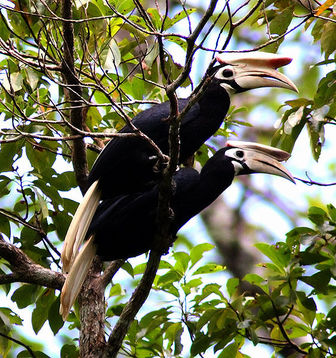Palawan Hornbill
Nine species of hornbill are found in the Philippines and the Palawan Hornbill is endemic to Palawan island, but has also been recorded on nearby islands of Balabac, Busuanga, Calauit, Culion and Coron. Most visiting birdwatchers travel to St Paul's National Park, Palawan to see this bird, but it is now uncommon. It acts as a bio-indicator due to its sensitivity to environmental changes. It is officially classified as vulnerable and its numbers have reduced by at least 20% in the last 10 years, due to habitat destruction and hunting for food and the live bird trade.

Original source: Llimchiu (talk). Original uploader was Llimchiu at en.wikipediaPermission(Reusing this file)Licensed under the GFDL by the author; Released under the GNU Free Documentation License.(Original text : GFDL-self)
Author: Llimchiu (talk). Original uploader was Llimchiu at en.wikipediaPermission(Reusing this file)Licensed under the GFDL by the author; Released under the GNU Free Documentation License.(Original text : GFDL-self)
Permission: GNU Free Documentation License
The Palawan Hornbill is classified as Vulnerable (VU), considered to be facing a high risk of extinction in the wild.
Tockus erythrorhychus Palawan Hornbill Anthracoceros marchei in Philippines. Southern Ground-hornbill (female because of bluish throat) about to swallow a grasshopper Great Hornbill Helmeted Hornbill This is a list of hornbill species, presented in taxonomic order. More
The Palawan hornbill, scientific name Anthracoceros marchei, is locally called a kalaw. Its a medium-sized hornbill thats black all over except for the white tail. Males are larger and have reddish-brown eyes, while females are smaller and have dark gray-brown eyes. The Palawan hornbill is a noisy bird that can be found in all forest storeys, secondary growth, mangroves, cultivated land, and bushlands close to forests. More
Palawan hornbills mainly eat fruit, but insects and lizards are also sometimes eaten. Pairs live in large tree holes well above the forest floor. During breeding season, the male locks the female inside the tree hole by blocking the entrance with feces and mud, leaving only a small opening for the females beak. During this time, the female is fully dependent on the male to feed her while she sits on the eggs full-time. More
The Palawan hornbill, the only hornbill of the Palawan Island archipelago, has black plumage which contrasts with its conspicuous white tail and pale ivory-yellow bill (4). Bare white skin, tinged with blue, surrounds the reddish-brown eyes and is also found on the throat. Female Palawan hornbills are smaller than males, with a greyish wash to their bills and casque, and dark grey-brown eyes (2). The Palawan hornbill’s raucous caaaww, or kreek-kreek can be heard in the early morning or late evening (4). More
On Culion Island, the Palawan hornbill used to be common and approachable; on Palawan however, it has been described as being very wild and wary. This suggests that in the past the hornbill has been hunted regularly on Palawan, and has developed a cautious nature as a result (4) (5). Hunting is likely to pose a continued threat today, along with the collection of eggs and chicks for food and the pet trade, and the destruction of its forest habitat (2) (5). More
feathered island family – the Palawan Hornbill from which our resort logo is based – are often seen and heard from various resort accommodations! Additional feathered varieties, less intrigued by resort occupants, are also found throughout the island's interior environments. Artistic renderings of many of the bird species endemic to Sangat Island can be previewed by clicking the various thumbnail images shown at the left. More
The Palawan Hornbill is endemic to Palawan island of the Philippines, but can also be found in nearby islands of Balabac, Busuanga, Calauit, Culion and Coron. The Palawan Hornbill, Anthracoceros marchei also known locally as Talusi in Filipino language is a 70-cm long forest-dweller hornbill. It has a white tail while the rest of its plumage is black. Its upper parts have a dark green gloss. Its large bill is creamy-white. More
the Palawan hornbill and the kingfisher attest to the abundance of fish in the water. On land are playful otters and bearcats, and a rainbow of wild orchids color the black marble cliffs. Isabelle is bursting with life. More
saving the Palawan hornbill in our own way. Don’t buy souvenirs such as hornbill feathers. Report pet shops that sell these birds. Its when we work together that we achieve something great. Hornbill footage shot in Lagen Island Resort, El Nido, Palawan, Philippines Host: Kring Soriano Environmental Officer Opening animation: Stompworks Studios http://www.stompworks-studios.com Created by: El Nido Resorts http://www.elnidoresorts. More
Social Behavior of the Palawan Hornbill (Anthracoceros marchei) in Captivity and its Response to Artificial Stimuli Annette P. Tamino, May Jasmin Estanislao, Denise Margaret Matias, Jeffrey Ramos, Kristine Jeanne Yap, Juan Manual Sebastian Zialcita The Palawan Hornbill (Anthracoceros marchei) is an endemic bird species in the Philippines belonging to the Family Bucerotidae. This bird's existence is threatened by the destruction of lowland forests and they are also easily trapped and sold as part of the illegal wildlife trade. More
A Palawan hornbill with a fig in its beak... 29" by 21" Framed Art Print 11. A Palawan hornbill with a fig in its beak... 24" by 18" Photographic Print 12. A Palawan hornbill with a fig in its beak... 16" by 12" Photographic Print 13. A Palawan hornbill with a fig in its beak... More
Family : Bucerotidae
Genus : Anthracoceros
Species : marchei
Authority : Oustalet, 1885
